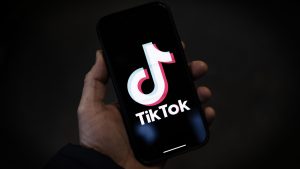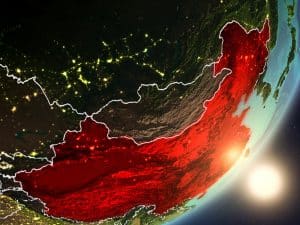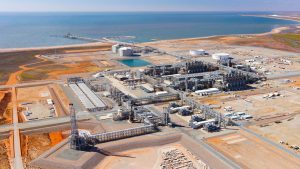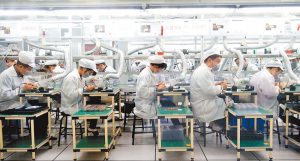Now entering its third month, the anti-extradition movement in Hong Kong shows no signs of dying down. Just last Sunday, more than 1.7 million people attended a rally, according to the organizers. This was the biggest protest in weeks—evidence that the movement continues to enjoy wide popular support. Hong Kong’s Chief Executive Carrie Lam still refuses to address the issues that have brought the citizens of the city into the streets in such historic numbers, even though she is now saying that she is “committed to listen,” purportedly in an effort to engage in dialogue with the protesters. Meanwhile, there are reports that people traveling from the island to the mainland are getting stopped by police and having their phones searched. UK consulate employee Simon Cheng is still being detained.
A few days ago, the situation in Hong Kong seemed to come to a head with China deploying paramilitary troops in the city of Shenzhen, which borders the mainland. Undeterred, the groups comprising the movement continue to organize the masses, and the demonstrations and marches continue. While the ultimate outcome of the uprising is impossible to determine at this point, it has had at least one concrete success—the suspension of the extradition bill—while also garnering significant international attention by once again shining a bright light on China’s authoritarian government. The protesters are fighting to maintain the semi-autonomous status of Hong Kong and the rights and freedoms associated with that. The democratic demands revolve around the protection of free speech, free elections, and freedom from juridical and political interference from China’s Communist Party (CCP).
The pro-democracy activism in the city goes back to the youth movements of the 1970’s, which fought for reforms under colonial rule and supported democratic movements in mainland China. Over the years, political activists from the mainland have sought refuge in Hong Kong and coordinated their political efforts with the help of the dissidents there. In the spring of 1989, several thousand peaceful protesters and bystanders were murdered in Tiananmen Square for demonstrating against political persecution and censorship and for greater transparency in government. After the massacre, the “pro-democracy camp” in Hong Kong became more expressly anti-Beijing. In 2003, protests erupted in opposition to an anti-subversion law, which stoked popular concerns over freedom of speech. After 2004, the movement expanded to encompass more groups, which led to the term “pan-democratic” being used more commonly. After the Umbrella Revolution in 2014, a stronger pro-independence movement emerged in Hong Kong, which, while now allied with the pan-dems, has advocated more confrontational tactics during the recent protests.
The groups that make up the anti-government movement now differ in their approach not only regarding method but also regarding goals and politics, with some of the “localist” organizations being significantly more right-wing than the rest of the movement. There are also anti-communist, racist (anti-mainland Chinese), and otherwise reactionary currents in evidence. If the leadership of the Umbrella movement was strongly anti-socialist and politically liberal, the protest movement today also does not go much beyond the ideological parameters of liberal democracy; as such, it is focused on universal suffrage, civil liberties, human rights, and political freedom—all within the framework of a capitalist market economy.
From Anti-Extradition to Broader Democratic Demands
Sparked by massive popular outrage over a piece of legislation that would have allowed Hong Kong authorities to extradite suspected criminals to mainland China, mass protests have brought the city to its knees. For eleven weeks already, the people of Hong Kong have been assembling in the streets, demanding the complete withdrawal of the extradition bill (Fugitive Offenders and Mutual Legal Assistance in Criminal Matters Legislation” amendment). While the “Special Administrative Region” (SAR) of Hong Kong does have extradition agreements with other countries, this bill would have meant the erosion of Hong Kong’s judicial independence from mainland China, which is known for its practices of political persecution and unfair trials.
Initially, it was claimed that the bill was necessary because it would have also provided for the extradition of people to Taiwan and specifically allowed for the extradition of a young man named Chan Tong-kai, who is suspected of having killed his girlfriend more than a year ago in Taiwan, and who is due to be released from jail in October. Hongkongers, of course, understand that this murder case is not the real reason why China wanted the amendment to become law and that there are political motivations behind the move to pass the extradiction bill.
Given China’s oppressive government, its systematic stifling of dissent and criticism, as well as its extremely poor human rights record, the stakes are high. China still carries out the death penalty, which was abolished in Hong Kong in 1993 and continues to be repudiated there. Since the 1997 handover of the city from Britain to China and the adoption of the “one country, two systems” agreement, the citizens of Hong Kong have enjoyed greater rights and freedoms than people in mainland China. Under the “Basic Law,” i.e. the constitution of the city, Hongkongers are guaranteed the right to free speech, the right to protest, a free press, an independent judiciary, religious freedom, and the right to strike. The “one country, two systems” model was to be in place for at least 50 years after reunification, and it is unclear what is going to happen in 2047.
So when the extradition bill was about to be pushed through the legislature, the writing was on the wall for everyone in Hongkong who remembers the case of the “Bookshop Five.” The incident involved an independent book store that sold material critical of the central government before five of its workers disappeared mysteriously between October and December, 2015. This news shocked the city and provoked an international uproar, especially after it was revealed that Chinese authorities had abducted and detained the five men under phony charges. The kidnappings were a clear attempt to intimidate publishers in Hong Kong, and an extradition agreement with mainland China would basically legalize such political abductions.
Demonstrations against the bill began as early as March and April of this year, but as events unfolded, the conflict between the pro-democracy or pan-democratic camp and the authorities has gone considerably beyond the circumstances surrounding the extradition bill. Over the course of the last two and a half months since July 9, the protesters’ demands have expanded in scope to include the resignation of Chief Executive Officer Carrie Lam Cheng Yuet-ngor, the rescinding of the characterization of the demonstrations as “riots,” the release of all the jailed protesters, and, centrally, an inquiry into the recent police brutality.
A key issue for Hongkongers is elections. What they want is the ability to freely elect the CE (Chief Executive) of Hong Kong. Under the “one country, two systems” rule, Hongkongers should be able to govern their city without interference, except in the areas of foreign relations and defense. However, the central government has been trying to control the electoral process by pre-selecting candidates. Since the pronouncement of something commonly referred to as the “31 August Decision,” an Elections Committee, which is seen as loyal to Beijing, is choosing three candidates, and only those three are allowed to run for office. It was this decision that sparked the Umbrella Revolution in 2014.
Escalation and Reaction
From the start, the protests have been massive and quite militant. Rallies and demonstrations are attended by tens and hundreds of thousands. In direct action mobilizations, the protesters have disrupted trains, prompted the cancelation of hundreds of flights, and erected street barricades all across the region. There have been protests in all 18 districts of Hong Kong with the exception of the southern district, and Hongkongers living overseas have joined the protests in 20 different countries. While the protest actions are generally peaceful, there have also been ongoing clashes with police, who stand accused of using excessive force. Notably, the sit-ins at the Hong Kong airport remained non-violent until a few days ago when skirmishes erupted after riot police pepper-sprayed protesters who had been blocking the security checkpoint, and crowds were attacked by cops across the city with tear gas and batons.
Importantly, there has also been a series of city-wide strikes that have included middle-class and working-class people from pilots and aviation staff to teachers, lawyers, engineers, construction workers, bus drivers, retail workers, civil servants, and even Disneyland employees. People of all ages—not just students and youth—participated in these strikes. According to the Hong Kong Confederation of Trade Unions, 350,000 workers came out on strike on August 5, causing the Hong Kong stock exchange to fall nearly 3% in one day.
Predictably, Hong Kong officials are condemning the actions as harmful to the economy, and the bourgeois press in the West is alerting us about dire consequences, publishing news pieces with headlines like “Global firms are sounding the alarm as escalating Hong Kong protests deal a ‘serious blow’ to the city’s outlook.” What a surprise: The capitalist class and their mouthpieces are concerned about profits! Chief Executive Carrie Lam is more concerned about the detrimental impact of this rebellion on big business in the city with the largest super-rich population in the world than about working people’s fears and expressed needs. (Incidentally, a CNBC journalist illustrated the fact that Lam is defending the interests of capital when he accidentally referred to her as the “CEO”—rather than the CE—of Hongkong in a slip of the tongue at the 2:30 minute mark here.)
The line put out by the government inverts the facts regarding who is responsible for the crisis. When she announced that the city was “on the verge of a very dangerous situation,” Carrie Lam was blaming the protesters for the conflict when in reality it is her own government and its military forces that pose a danger to the safety and rights of the people. And of course it was she who initiated the conflict,with her decision to change Hong Kong’s existing extradition policy. In another statement, Carrie Lam portrayed the protesters as a fringe group with no vested interest in society. According to her, “a small minority of people… [don’t] mind destroying Hong Kong. They have no stake in society which so many people have helped to build. And that’s why they resorted to all this violence and obstructions, causing huge damage to [the] economy and to the daily lives of people.”
The real damage to Hong Kong society right now is caused by the state, however. As the protests continue to evolve, so have the means of repression. Permits for demonstrations have been denied, demonstrators are being chased by police in riot gear, hundreds (more than 700, as of August 4) have been arrested, and over two thousand people have been injured. Police have fired tear gas and rubber bullets to get crowds to disperse, including in confined spaces like subway stations. On August 11, a young woman was struck by a police projectile and, as a result, may be permanently blind; since then, eye patches and images of a bloody eye have become symbols of the rebellion. There are also reports of gangs (the so-called “triads,” one of the mafias operating in the area) beating up protesters with sticks and metal rods. These attacks seem to be happening with the tacit agreement or even at the behest of the government.
Meanwhile, China’s reaction has grown increasingly heavy-handed. Beijing knows the situation is a problem and has taken steps to quash the unrest. About a week ago, after the arrest of a pilot who had participated in a protest, and after the flight attendants’ union had signed a statement with other airport employees in solidarity with the protesters, China demanded that Hong Kong suspend any employee of the Cathay Pacific airline who is seen supporting the protests. There have also been boycott campaigns against companies that have taken the side of the protesters, and stores have been vandalized by pro-government forces. At the moment, it does not seem likely that China will intervene militarily and that it will instead continue its propaganda offensive while waiting for the protests to fizzle out. At the same time, Chinese agents have started to operate on a regular basis in Hong Kong: Protesters caught a Chinese auxiliary police and an agent of the Chinese Ministry of State Security infiltrating the demonstrations.
Beijing does not care to dress up its message when it issues statements saying that “Those who play with fire will perish by it,” and informing Honkongers that they should not “underestimate the firm resolve of the central government.” In a rather dramatic turn of events, the military (the People’s Liberation Army garrison in Hong Kong) released a video on August 1 in which they are conducting drills and waging a full-fledged war against protesters (complete with water cannons, gunfire, tanks, helicopters, and rocket launchers. It doesn’t take much to see that the three-minute clip is a warning to the protest movement to “Stop Charging Or We Use Force,” words that appear on the signs held up by the troops in the video as well as by the police in the streets of Hong Kong. The not-so-thinly veiled message is made even more apparent by the fact that the soldiers in the video chant in Cantonese, which is the language most Hongkongers speak, whereas the subtitles are in “simplified Chinese” and English.
On Monday, August 12, Chinese officials for the first time labeled the protests as “close to terrorism,” and one went on record with this ominous injunction: “We should relentlessly crack down on such violent criminal acts without mercy.” If China’s rhetoric is meant to delegitimize and demonize the movement, the protesters have developed their own methods in the struggle against the government’s efforts to contain and control them.
Like Water
From the start, protesters have drawn upon a wide variety of tactics, including rallies, occupations, and blockades of streets and buildings. They wear masks and helmets to protect their identifies and their bodies. They point lasers at facial recognition cameras. In what has been described as a “cat and mouse game” with police, they assemble in one part of the city only in order to disperse and assemble somewhere else. They hit several targets at the same time. They organize via social media and messaging apps like Facebook and Telegram, both of which are blocked in China but not in Hong Kong.
One of the slogans that appears at the anti-government protests is “Be water” or “We are like water!” Inspired by Kung Fu movie star Bruce Lee, this motto captures the fact that a lot of what the movement is doing is strongly reminiscent of the philosophy of the ancient military advisor Sun Tzu, whose ideas are also reflected in Chinese martial arts. In The Art of War, “Master Sun” argued that in order to win a battle, one must exhibit maximum adaptability, like water. Being malleable and flexible to the point of formlessness, according to the general, enables one to be “unfathomable” to the enemy and thereby to confuse, evade, outwit, and ultimately overcome them. Water, being both the softest and the strongest element, does not have a fixed shape; it shapes itself according to whatever surrounds it, i.e. the given situation. Water is determined by the circumstances, makes use of them, and thus masters them.
Further echoing these ideas, there is an “art” to the way the protesters talk to each other and to their allies in and beyond the movement. The means they use to communicate amongst themselves and with the population in the city as well as with the rest of the world have been remarkably creative. Relying on technology as well as physical material in the “battle for public opinion,” the rebellion distributes and spreads information via cleverly designed posters, a sign language system to coordinate supply chains, and peer-to-peer services like AirDrop. They hand out fliers to international travelers at the airport, create so-called “Lennon walls,” and use humor and parody in their campaigns.
However, some of the lessons of The Art of War have not played an important role in the protests, such as the central importance of organization and leadership. Of course, a mass movement is not an army, but the success of the uprising may well depend on how the groups involved can maintain the momentum and develop a strategy to win. The protests have been described as horizontal and leaderless, which is not entirely true, but there are certainly anarchic tendencies on display. While the protests are organized by various groups (such as the Civil Human Rights Front, a coalition of pan-democratic NGO’s, trade unions, and liberal political parties), they are also distinctly anti-hierarchical.
The groups that participate in the actions are not united by a common platform or a set of political objectives, apart from the five demands. Political activist Yu Waipan from Hong Kong attributes the deliberate emphasis on spontaneity and decentralized organizing to the repression (and the need for anonymity) and the lack of a tradition of union and party politics in Hong Kong. The resulting absence of leadership is identified by Yu Waipan as a major problem.
The Limits of Bourgeois Democracy
So far, the protests have had some success. The extradition bill has been indefinitely suspended, though not yet withdrawn. However, Carrie Lam is refusing to resign, and China is still expecting her to get the situation under control. Her rhetoric is reflective of the recalcitrance of the administration. When at the August 9 press conference mentioned above she referred to the protesters as a “small minority,” she made it clear that she did not intend to take the protesters seriously. The comment was also laughable given that she had been forced by a march of nearly two million people (out of a total population of 7 million) to change course on the extradition issue. Carrie Lam also compared Hongkongers to children and herself to their mother by saying that it is bad parenting to give into every demand. This analogy was immediately met by an open letter signed by 44,000 women, in which the CE was lambasted for the police brutality against the “children of Hong Kong” and soundly chastised for her patronizing attitude.
It is crucial to note that the protesters have not put forth any particular economic demands. This is surprising for a city with the highest levels of inequality in all of Asia, skyrocketing rents, and stagnating wages. In a place that has been rated one of the top three global financial hubs, the wealth gap is at its most extreme in the last 45 years, a fifth of the population is destitute, and the homelessness rate has gone up by 30% in the past five years (the real numbers likely being much higher than the official count of registered “street sleepers”). But even though one in four children and one in three elderly people live beneath the poverty line in Hong Kong, the protests do not have an anti-capitalist message. The actual message of the protesters is anti-government, anti-authoritarian, and anti-CCP. The imagery used is based on Hollywood and anime styles, illustrating the fact that the orientation of the movement is toward Western (bourgeois) democracy. Giving further expression to this fact was the explanation that a group of masked protesters gave at a press conference last Tuesday, August 6, when they made a formal statement saying that the struggle was in “pursuit of democracy, liberty and equality.”
The central government of China has of course already accused the U.S. and other Western countries of being behind the protests. Based on the claim that a member of the U.S. consulate in Hong Kong met with protesters, including Joshua Wong (one of the leaders of the Umbrella Revolution who had been released from prison after having been jailed a second time), Beijing is making the case that a “black hand” is meddling in China’s affairs and is engineering the unrest. Is the West giving money to any of the organizations involved in the movement? Of course. The anti-militant Hong Kong Confederation of Trade Unions, for example, which supports the protests but is generally loyal to the HK and Chinese government, receives funds from the U.S. National Endowment for Democracy, a governmental operation that basically does the same thing overtly as the CIA has done covertly: support anti-left opposition movements and rightist unions around the world, including in Nicaragua and Venezuela.
There can be no doubt that the U.S. and the rest of the capitalist world is more than grateful for this opportunity to see China look bad in the eyes of the world. However, to say that the protests are orchestrated by the West is ridiculous, just as it is absurd to claim that the protests in Hong Kong are a tool of Western imperialism.
The Trump administration is calling on China’s president Xi Jinping to sit down with the protesters and find a “humanitarian” solution to the crisis unless it wants to jeopardize the prospects of a trade deal. Certainly, the objective there is not to side with the protesters and with the cause of democratic reform but rather to engage in more economic nationalist posturing as Trump continues his trade war with China.
The socialist left in the U.S. and elsewhere should support the mass struggle in Hong Kong because it is a struggle against repression and state violence. Despite its internal contradictions, the protest movement in Hong Kong is a democratic movement that demands our solidarity. Whether the protesters will be able to accomplish their immediate goals remains an open question, and much will depend on Carrie Lam, and whether she will continue to refuse to make any other concessions. More importantly, the future of the movement will hinge on how it will or will not manage to overcome its current organizational and political limitations. If there is no left leadership, or at least a strong socialist voice, the protests won’t be able to go beyond acts of resistance against further incursions into Hong Kong’s civil rights.










